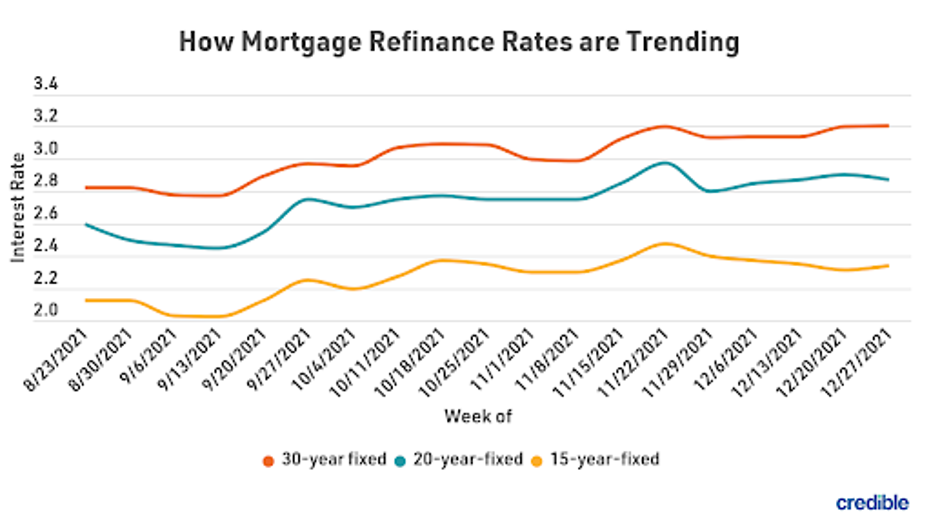Refinance rates rise: 20- and 15-year terms emerge as best bargains | Jan. 4, 2022
Rates for all repayment terms remain lower than pre-pandemic purchase rates, so homeowners still have time to save.

Check out the mortgage refinancing rates for Jan. 4, 2022, which are up from yesterday. (iStock)
Based on data compiled by Credible, current mortgage refinance rates rose across all repayment terms since yesterday. With rates predicted to continue rising throughout 2022, homeowners considering a refinance may want to act sooner rather than later.
- 30-year fixed-rate refinance: 3.440%, up from 3.190%, +0.250
- 20-year fixed-rate refinance: 3.000%, up from 2.875%, +0.125
- 15-year fixed-rate refinance: 2.500%, up from 2.375%, +0.125
- 10-year fixed-rate refinance: 2.500%, up from 2.250%, +0.250
Rates last updated on Jan. 4, 2022. These rates are based on the assumptions shown here. Actual rates may vary.
While refinance rates rose across all repayment terms today, 20-year and 15-year fixed-rate refinances marked the smallest increases — an incremental bump of just 0.125%. At just 3%, a 20-year refinance could allow homeowners with pre-pandemic mortgages to lower their interest rates by 1%. And by refinancing into a 15-year mortgage, homeowners could secure one of the lowest available refinance rates while paying off their mortgages faster.

These rates are based on the assumptions shown here. Actual rates may vary.
If you’re thinking of refinancing your home mortgage, consider using Credible. Whether you're interested in saving money on your monthly mortgage payments or considering a cash-out refinance, Credible's free online tool will let you compare rates from multiple mortgage lenders. You can see prequalified rates in as little as three minutes.
Current 30-year fixed refinance rates
The current rate for a 30-year fixed-rate refinance is 3.440%. This is up from yesterday. Refinancing a 30-year mortgage into a new 30-year mortgage could lower your interest rate, but may not have much effect on your total interest costs or monthly payment. Refinancing a shorter term mortgage into a 30-year refinance could result in a lower monthly payment but higher total interest costs.
Current 20-year fixed refinance rates
The current rate for a 20-year fixed-rate refinance is 3.000%. This is up from yesterday. By refinancing a 30-year loan into a 20-year refinance, you could secure a lower interest rate and reduce total interest costs over the life of your mortgage. But you may get a higher monthly payment.
Current 15-year fixed refinance rates
The current rate for a 15-year fixed-rate refinance is 2.500%. This is up from yesterday. A 15-year refinance could be a good choice for homeowners looking to strike a balance between lowering interest costs and retaining a manageable monthly payment.
Current 10-year fixed refinance rates
The current rate for a 10-year fixed-rate refinance is 2.500%. This is up from yesterday. A 10-year refinance will help you pay off your mortgage sooner and maximize your interest savings. But you could also end up with a bigger monthly mortgage payment.
You can explore your mortgage refinance options in minutes by visiting Credible to compare rates and lenders. Check out Credible and get prequalified today.
Rates last updated on Jan. 4, 2022. These rates are based on the assumptions shown here. Actual rates may vary.
How much equity do I need to refinance my home?
When you apply for a refinance mortgage, lenders will consider how much equity you currently have in your home. If you don’t meet the lender’s equity requirements, you may not qualify for a refinance with that lender.
Requirements can vary from lender to lender, and depend on the type of refinance you’re doing — rate-and-term vs. cash-out refinance.
For a rate-and-term refinance, you may be able to qualify with as little as 5% home equity. But your lender will likely require you to purchase private mortgage insurance. Most lenders will prefer a loan-to-value ratio of at least 20% — meaning the amount you owe on your mortgage is no more than 80% of your home’s total value.
Generally, for a cash-out refinance, most lenders will want to see that you have a loan-to-value ratio, or LTV, of at least 20%. But some lenders may be flexible if you have good credit, a history of on-time bill payments and are willing to accept a higher interest rate.
To calculate your loan-to-value ratio, simply divide your loan balance by the current value of your home. For example, if your home’s value is $350,000 and you owe $325,000, your LTV is just under 93% — and you may have difficulty qualifying for a refinance.
How to get your lowest mortgage refinance rate
If you’re interested in refinancing your mortgage, improving your credit score and paying down any other debt could secure you a lower rate. It’s also a good idea to compare rates from different lenders if you're hoping to refinance so you can find the best rate for your situation.
Borrowers can save $1,500 on average over the life of their loan by shopping for just one additional rate quote, and an average of $3,000 by comparing five rate quotes, according to research from Freddie Mac.
Be sure to shop around and compare rates from multiple mortgage lenders if you decide to refinance your mortgage. You can do this easily with Credible’s free online tool and see your prequalified rates in only three minutes.
How does Credible calculate refinance rates?
Changing economic conditions, central bank policy decisions, investor sentiment and other factors influence the movement of mortgage refinance rates. Credible average mortgage refinance rates are calculated based on information provided by partner lenders who pay compensation to Credible.
The rates assume a borrower has a 740 credit score and is borrowing a conventional loan for a single-family home that will be their primary residence. The rates also assume no (or very low) discount points and a down payment of 20%.
Credible mortgage refinance rates will only give you an idea of current average rates. The rate you receive can vary based on a number of factors.
What is the average cost of a refinance?
Refinancing a mortgage can yield significant interest savings over the life of a loan. But all those savings don’t come for free. Generally, you’ll encounter costs — $5,000 on average, according to Freddie Mac — when refinancing your mortgage.
Your exact refinancing costs will depend on multiple factors, including the size of your loan and where you live. Typical refinancing costs include:
- The cost of recording your new mortgage
- Appraisal fees
- Attorney fees
- Lender fees, such as origination or underwriting
- Title service fees
- Credit report fees
- Mortgage points
- Prepaid interest charges
Keep in mind there’s no such thing as a truly no-cost refinance. Lenders who market "no-cost loans" typically charge a higher interest rate and roll the costs into the loan — which means you’ll pay more interest over the life of the loan.
Credible also has a partnership with a home insurance broker. You can compare free home insurance quotes through Credible's partner here. It's fast, easy and the whole process can be completed entirely online.
Think it might be the right time to refinance? Be sure to shop around and compare rates with multiple mortgage lenders. You can do this easily with Credible and see your prequalified rates in only three minutes.
Rates last updated on Jan. 4, 2022. These rates are based on the assumptions shown here. Actual rates may vary.
Have a finance-related question, but don't know who to ask? Email The Credible Money Expert at moneyexpert@credible.com and your question might be answered by Credible in our Money Expert column.
As a Credible authority on mortgages and personal finance, Chris Jennings has covered topics that include mortgage loans, mortgage refinancing, and more. He’s been an editor and editorial assistant in the online personal finance space for four years. His work has been featured by MSN, AOL, Yahoo Finance, and more.
